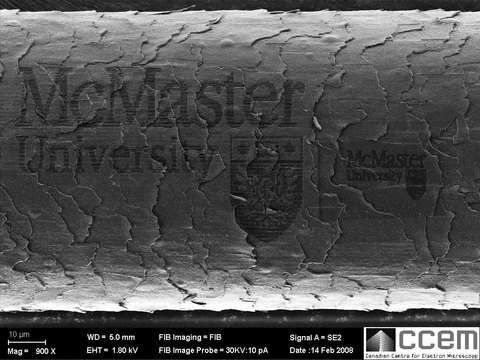
Gallium Ions
lourdes sanchez bayas — April 6, 2008 — Unique
References: gadgets.boingboing.net
What you see on the pictures is human hair magnified many, many times. Carved on the hair is the logo of McMaster University in Ontario Canada. How is that possible? Dr. Ray LaPierre, a professor at the Department of Engineering at that institution, came up with a way to tattoo hair using something called gallium ions.
"Dr. LaPierre's group used a focus ion beam microscope (FIB) to shoot a beam of gallium ions at the surface of a human hair, carving atoms off the of the surface of the hair to etch these McMaster University logos," Boing Boing explains. "When not tattooing hair, they'll use the FIB microscope to fabricate nanoscale devices."
Eyes, teeth and now hair. I can't wait to be able to get a tat on my liver!
"Dr. LaPierre's group used a focus ion beam microscope (FIB) to shoot a beam of gallium ions at the surface of a human hair, carving atoms off the of the surface of the hair to etch these McMaster University logos," Boing Boing explains. "When not tattooing hair, they'll use the FIB microscope to fabricate nanoscale devices."
Eyes, teeth and now hair. I can't wait to be able to get a tat on my liver!
Trend Themes
1. Hair Tattoos - The trend of using gallium ions to tattoo logos and designs onto human hair.
2. Nanoscale Devices - The trend of fabricating nanoscale devices using focus ion beam microscopes (FIB).
3. Organ Tattoos - The upcoming trend of tattooing designs onto internal organs using innovative techniques.
Industry Implications
1. Beauty & Personal Care - The beauty industry can explore new hair tattooing techniques and services to cater to the growing demand.
2. Nanotechnology - Nanotechnology companies can capitalize on the trend of fabricating nanoscale devices using focused ion beams.
3. Medical Technology - The medical technology field can explore innovative tattooing techniques for internal organs, opening up new possibilities in healthcare.
4.5
Score
Popularity
Activity
Freshness























